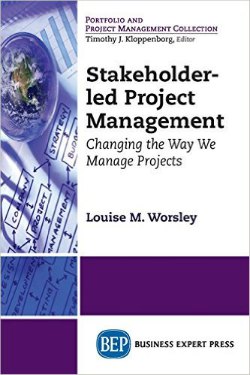What is Stakeholder-led Project Management?
This blog is reader-supported. When you purchase something through an affiliate link on this site, I may earn some coffee money. Thanks! Learn more.
“I am convinced that stakeholders must always impact upon the way we manage our projects,” writes Louise M. Worsley in Stakeholder-led Project Management: Changing the Way We Manage Projects. “I hope I can convince you.”
I’m probably the ideal audience for this book: I don’t need convincing. I wrote a book about stakeholder engagement too.
She goes on:
Stakeholder management is not a series of steps to be gone through, but a perspective that when fathomed and its implications understood, always makes a difference to the conduct of the project. Or put more bluntly: If you think you are doing stakeholder management and it’s not making a difference to the way you run your project, then you aren’t!
This book sets out a way to manage stakeholders that many project managers will recognize:
- Identify and document
- Analyze
- Develop strategies
- Plan approach
- Engage
- Watch, listen, react and review
The bulk of the book is taken up with explaining these steps in more detail and offering practical solutions for making them work on your project.
3 types of project
Talking of projects, Worsley explains that there are 3 different types of project.
Stakeholder-neutral
In these projects, stakeholders are identified and communicated with in the ‘normal’ way, but their power and influence is relatively low.
IT projects often fall into this category. The project resources can broadly get on with it and the stakeholders don’t need to be terribly involved in the work.
Stakeholder-sensitive
This type of project impacts on people and the way they work, meaning that stakeholders are far more invested.
It’s important to spend time with the people involved as they’ll help you work out how best to deliver the outcomes. There is a lot of
Stakeholder-led
The final type of project at the other end of the continuum is where stakeholders have a lot of power and influence over the project. These could be business transformation projects and have a definite requirement to engage large numbers of influential stakeholders.
Who is a project stakeholder?
Worsley says stakeholders are those people you would consider using your engagement plans on. This, she says, excludes you and the project team. They are not people you manage through stakeholder management, you manage them through team management.
I don’t agree. If the point is to flex your engagement style, then you can flex it in a way that makes it include the team. Team management happens as well, but there’s no reason not to engage your team.
Worsley also excludes steering group members from ‘engagement’ saying that the governance process is enough for them. I am more aligned to agree with that.
I will often not specifically ‘engage’ senior steering group members because they have already heard the information from me through our governance processes. However, in terminology terms I’d still bundle it all together into ‘stakeholder engagement’ though.
Categorizing stakeholders
She writes about splitting stakeholders in a way that I hadn’t come across before: role-based and agenda-based.
Role-based stakeholders
This group has influence or power within the project because of the expertise they bring to the team. They have an actual responsibility on the project with regards to the work.
Agenda-based stakeholders
Agenda-based stakeholders have a particular position or opinion on the project. They might not have a formal role on the project team but they exert their influence through their involvement.
Role- and agenda-based stakeholders map on to the 3 types of projects. Worsley explains this in detail but the bottom line is that the more complex a project, the more agenda-based stakeholders you have.
 How to do engagement
How to do engagement
The book is heavy on case studies, which I started out by enjoying but by the end I felt there were a few too many. This is personal preference and not particularly a disadvantage to the book.
Through the case studies you can pick up practical examples of how to do engagement on your projects. There are plenty of tools scattered through to help you identify, record, map, analyze and track your stakeholders.
I really liked the (short) anecdote on reporting in the chapter about project communication. It tells the story of a team that realized they could send their status reports automatically from their enterprise project management tool. So they did.
After 3 weeks they had so many complaints about people being bombarded with emails that they had to turn the functionality off.
Each chapter ends with reflection questions and references.
I learned something from this book, and I’m sure you will too. It’s a comprehensive guide to making your stakeholder relationships work well.
Get Stakeholder-led Project Management on Amazon.
A version of this article appeared on the site in 2020.

 How to do engagement
How to do engagement